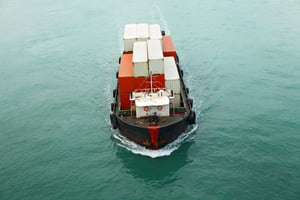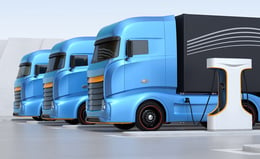What Does the Future Hold for On-Demand Trucking?
Martin Pahulje - June 15, 2021

The current state of business is all about digitization. Thanks to the ongoing development of smart technology, every aspect of the supply chain has been digitized and optimized, increasing speed, accuracy, and success. As we live in a consumer culture where demand is expected to be met instantly, companies must be equipped with these capabilities. The pressure to meet demand quickly is felt through every step of the supply chain, all the way to delivery. It can be challenging to imagine how one would optimize delivery and trucking; after all, you can’t digitize trucks, right? That used to be the case, but the mentality of on-demand capabilities has been extended to trucking. On-demand trucking allows shippers to find available truck drivers with the right space, in the right location, in real-time. Not only does this benefit customers, but manufacturers too. On-demand trucking eliminates the need to establish contracts and schedule vehicles far in advance, cutting out the middle man, saving shippers significant time and money. Clearly, this is a system worth implementing in our current market, but what is the future of on-demand trucking.
On-Demand Technology
The COVID-19 pandemic drastically changed how businesses operate. To comply with regulations, companies had to transition to contactless and digitally-based operations. As a result, digital capabilities are booming, and technology is advancing rapidly, which is evident through the growing capabilities of on-demand trucking. Thanks to advanced technology, there is an opportunity to match drivers, equipment, and market capacity between trucks and shippers to optimize delivery. A significant benefit of this is the increased shipping speed, but that's not where the innovation ends. With on-demand trucking, shippers can access quotes more quickly while drivers can secure loads in real-time.
In addition to matching capabilities, on-demand trucking offers real-time pricing and mapping functions, all of which are integrated with shippers' systems for easy access. These developments allow for trucking organizations to attract more high-quality carriers and independent operators onto  their platforms. Some organizations have fully embraced these systems, allowing them to offer customers easy access to guaranteed price and capacity options that can be compared to contracted carrier rates. Furthermore, the need to contract with carriers months or years in advance is eliminated. The needs of shippers are constantly changing, and with on-demand trucking, these needs can be adjusted with ease. Specialized capacities will also become more available. Many shippers have products that require special accommodations, such as refrigeration, which can make obtaining trucks more complex. With on-demand trucking technology, shippers can sort through their options to find a truck that completely meets their needs. This flexibility is allowing organizations to grow, expanding their own operations to match their expanding customer base.
their platforms. Some organizations have fully embraced these systems, allowing them to offer customers easy access to guaranteed price and capacity options that can be compared to contracted carrier rates. Furthermore, the need to contract with carriers months or years in advance is eliminated. The needs of shippers are constantly changing, and with on-demand trucking, these needs can be adjusted with ease. Specialized capacities will also become more available. Many shippers have products that require special accommodations, such as refrigeration, which can make obtaining trucks more complex. With on-demand trucking technology, shippers can sort through their options to find a truck that completely meets their needs. This flexibility is allowing organizations to grow, expanding their own operations to match their expanding customer base.
On-demand trucking is also significantly benefiting the market as a whole. Because shippers and truckers can be matched efficiently, satisfying demand on both ends, there is a growing potential for better capacity utilization in the market. This allows carriers to fill empty miles and shippers to find the truck they need when they need them. As this prevents idle trucks and delayed shipments, on-demand trucking brings significant benefits in terms of cost savings. Shippers can find trucks of the right size, ensuring that space is maximized for time and cost-efficiency. Additionally, because trucks are being used more efficiently, this results in reduced emissions. Trucks contribute a significant amount to the high levels of carbon emissions produced by the manufacturing industry. In optimizing the trucking process, trucks are maximizing their time and space. By eliminating unnecessary trips, trucks will produce fewer emissions which is excellent for compliance and sustainability purposes.
Trucking in the New Normal
If you ordered a product online in the past year, you probably noticed that it took longer than average to arrive. During the height of the pandemic, businesses were franticly trying to adjust operations to fit in with the new normal we are living in. An unexpected implication of this was its impact on the  trucking workforce. Many small carriers exited the market in addition to individual drivers leaving their roles. This, combined with a sudden decrease in areas of manufacturing and the rapid increase in e-commerce, created a perfect storm. One year later, the market is beginning to bounce back, but operations have radically changed, and it's unlikely that they will return to how they were. A silver lining of this has been the sudden boom of on-demand trucking.
trucking workforce. Many small carriers exited the market in addition to individual drivers leaving their roles. This, combined with a sudden decrease in areas of manufacturing and the rapid increase in e-commerce, created a perfect storm. One year later, the market is beginning to bounce back, but operations have radically changed, and it's unlikely that they will return to how they were. A silver lining of this has been the sudden boom of on-demand trucking.
Leveraging technology to connect with partners across the network has become a necessity for shippers. Organizations have learned the value of flexibility, and they can see that it is offered by on-demand trucking. With this system, shippers can find affordable trucking options with ease, allowing them to return to their normal state of operations. Drivers, too, are benefiting as they are finding new sources for loads on different routes.
The Future of On-Demand Trucking
Technology will continue to advance, and this will be seen in the trucking industry. While the growth of on-demand trucking may be slow-moving at the moment, it is expected to increase as on-demand culture does. Factors driving the growth of on-demand trucking, including volatile market conditions, rising spot and contract rates, and trucking apps, had the need for on-demand trucking at a steady incline. As most of these factors will not be changing drastically in the near future, it is feasible that on-demand trucking is the future of freight and transportation management and load matching. While the pandemic slightly slowed the growth rate of on-demand trucking, as organizations bounce back, we imagine that on-demand trucking will too.
As the on-demand trucking marketplace becomes more connected, the gap between shippers and truckers will shrink even more. With enhanced capabilities, the trucking process will become more and more efficient, optimizing supply chains from the last mile. Optimizing the shipping process through on-demand trucking will expedite shipping while simplifying the process of obtaining trucks that fit a company’s needs. The bottom line is: on-demand trucking offers shippers a proven and flexible way of conducting business. With real-time visibility, specialized capacity, and a simpler way to access settlement, on-demand trucking is an excellent development in the transportation industry, and it will only continue to grow.
Click below to download our guide on vehicle routing optimization.
LATEST POSTS
- Understand Circular Economy in The Manufacturing Industry
- How Can Industry 4.0 IT Integration Be Achieved Smoothly?
- The Significance of Order Sequencing in Discrete Manufacturing
- How to improve your Supply Chain Management: The Power of Control Towers
- Optimizing Human Resource Scheduling in Manufacturing: A Technological Approach



